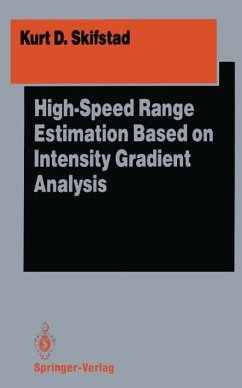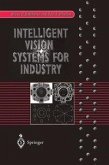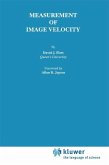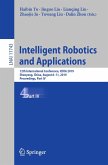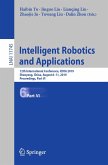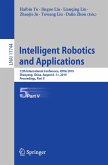Kurt D. Skifstad
High-Speed Range Estimation Based on Intensity Gradient Analysis (eBook, PDF)
40,95 €
40,95 €
inkl. MwSt.
Sofort per Download lieferbar

20 °P sammeln
40,95 €
Als Download kaufen

40,95 €
inkl. MwSt.
Sofort per Download lieferbar

20 °P sammeln
Jetzt verschenken
Alle Infos zum eBook verschenken
40,95 €
inkl. MwSt.
Sofort per Download lieferbar
Alle Infos zum eBook verschenken

20 °P sammeln
Kurt D. Skifstad
High-Speed Range Estimation Based on Intensity Gradient Analysis (eBook, PDF)
- Format: PDF
- Merkliste
- Auf die Merkliste
- Bewerten Bewerten
- Teilen
- Produkt teilen
- Produkterinnerung
- Produkterinnerung

Bitte loggen Sie sich zunächst in Ihr Kundenkonto ein oder registrieren Sie sich bei
bücher.de, um das eBook-Abo tolino select nutzen zu können.
Hier können Sie sich einloggen
Hier können Sie sich einloggen
Sie sind bereits eingeloggt. Klicken Sie auf 2. tolino select Abo, um fortzufahren.

Bitte loggen Sie sich zunächst in Ihr Kundenkonto ein oder registrieren Sie sich bei bücher.de, um das eBook-Abo tolino select nutzen zu können.
A new algorithm (Intensity Gradient Analysis) provides the basis for fast and accurate range estimation. The algorithm is extremely efficient, using only a fraction of the computational effort required by existing techniques.
- Geräte: PC
- ohne Kopierschutz
- eBook Hilfe
- Größe: 23.63MB
Andere Kunden interessierten sich auch für
![Intelligent Vision Systems for Industry (eBook, PDF) Intelligent Vision Systems for Industry (eBook, PDF)]() Bruce G. BatchelorIntelligent Vision Systems for Industry (eBook, PDF)112,95 €
Bruce G. BatchelorIntelligent Vision Systems for Industry (eBook, PDF)112,95 €![Measurement of Image Velocity (eBook, PDF) Measurement of Image Velocity (eBook, PDF)]() David J. FleetMeasurement of Image Velocity (eBook, PDF)72,95 €
David J. FleetMeasurement of Image Velocity (eBook, PDF)72,95 €![Three-Dimensional Machine Vision (eBook, PDF) Three-Dimensional Machine Vision (eBook, PDF)]() Takeo KanadeThree-Dimensional Machine Vision (eBook, PDF)232,95 €
Takeo KanadeThree-Dimensional Machine Vision (eBook, PDF)232,95 €![Intelligent Robotics and Applications (eBook, PDF) Intelligent Robotics and Applications (eBook, PDF)]() Intelligent Robotics and Applications (eBook, PDF)40,95 €
Intelligent Robotics and Applications (eBook, PDF)40,95 €![Intelligent Robotics and Applications (eBook, PDF) Intelligent Robotics and Applications (eBook, PDF)]() Intelligent Robotics and Applications (eBook, PDF)40,95 €
Intelligent Robotics and Applications (eBook, PDF)40,95 €![Vision-Based Mobile Robot Control and Path Planning Algorithms in Obstacle Environments Using Type-2 Fuzzy Logic (eBook, PDF) Vision-Based Mobile Robot Control and Path Planning Algorithms in Obstacle Environments Using Type-2 Fuzzy Logic (eBook, PDF)]() Mahmut DirikVision-Based Mobile Robot Control and Path Planning Algorithms in Obstacle Environments Using Type-2 Fuzzy Logic (eBook, PDF)72,95 €
Mahmut DirikVision-Based Mobile Robot Control and Path Planning Algorithms in Obstacle Environments Using Type-2 Fuzzy Logic (eBook, PDF)72,95 €![Intelligent Robotics and Applications (eBook, PDF) Intelligent Robotics and Applications (eBook, PDF)]() Intelligent Robotics and Applications (eBook, PDF)40,95 €
Intelligent Robotics and Applications (eBook, PDF)40,95 €-
-
-
A new algorithm (Intensity Gradient Analysis) provides the basis for fast and accurate range estimation. The algorithm is extremely efficient, using only a fraction of the computational effort required by existing techniques.
Dieser Download kann aus rechtlichen Gründen nur mit Rechnungsadresse in A, B, BG, CY, CZ, D, DK, EW, E, FIN, F, GR, HR, H, IRL, I, LT, L, LR, M, NL, PL, P, R, S, SLO, SK ausgeliefert werden.
Produktdetails
- Produktdetails
- Verlag: Springer US
- Seitenzahl: 182
- Erscheinungstermin: 6. Dezember 2012
- Englisch
- ISBN-13: 9781461231127
- Artikelnr.: 43992274
- Verlag: Springer US
- Seitenzahl: 182
- Erscheinungstermin: 6. Dezember 2012
- Englisch
- ISBN-13: 9781461231127
- Artikelnr.: 43992274
- Herstellerkennzeichnung Die Herstellerinformationen sind derzeit nicht verfügbar.
1 Introduction.- 1.1 Purpose.- 1.2 Philosophy.- 1.3 The Structure of This Thesis.- 2 Approaches to the Depth Recovery Problem.- 2.1 Sensing Modalities.- 2.2 Vision as a Primary Mode of Sensing.- 2.3 Literature Survey.- 2.4 Summary.- 3 Depth Recovery.- 3.1 Depth Recovery Using Translational Sensor Motion.- 3.2 Special Case: Axial Camera Motion.- 3.3 Special Case: Lateral Camera Motion.- 3.4 The Parameters Needed for Depth Recovery.- 4 Theoretical Basis for IGA.- 4.1 Acquiring a Sequence of Images.- 4.2 Two Ideas and Their Implications.- 5 Intensity Gradient Analysis.- 5.1 Isolating Fixed Image Displacements Using Intensity Gradients.- 5.2 Why Do More Work?.- 5.3 Extending to Two Dimensions.- 5.4 The IGA Algorithm.- 6 Implementation Issues.- 6.1 Problems with Real-World Sensors.- 6.2 Uncertainty in the Camera Motion Parameters.- 6.3 Moving Objects.- 6.4 Summary.- 7 Fixed Disparity Surfaces.- 7.1 Examples of FDS's.- 7.2 Interpreting FDS's.- 7.3 Fixed Disparity Surfaces and Conventional Stereo.- 8 Experiments.- 8.1 Experimental Setup.- 8.2 Calibration Procedures.- 8.4 Outdoor Scenes.- 8.5 Conclusions.- 9 An Application: Vision-Guided Navigation Using IGA.- 9.1 Navigation.- 9.2 Experimental Setup.- 9.3 Experiments.- 10 Conclusion.- 10.1 Future Research.- 10.2 Contribution.
1 Introduction.- 1.1 Purpose.- 1.2 Philosophy.- 1.3 The Structure of This Thesis.- 2 Approaches to the Depth Recovery Problem.- 2.1 Sensing Modalities.- 2.2 Vision as a Primary Mode of Sensing.- 2.3 Literature Survey.- 2.4 Summary.- 3 Depth Recovery.- 3.1 Depth Recovery Using Translational Sensor Motion.- 3.2 Special Case: Axial Camera Motion.- 3.3 Special Case: Lateral Camera Motion.- 3.4 The Parameters Needed for Depth Recovery.- 4 Theoretical Basis for IGA.- 4.1 Acquiring a Sequence of Images.- 4.2 Two Ideas and Their Implications.- 5 Intensity Gradient Analysis.- 5.1 Isolating Fixed Image Displacements Using Intensity Gradients.- 5.2 Why Do More Work?.- 5.3 Extending to Two Dimensions.- 5.4 The IGA Algorithm.- 6 Implementation Issues.- 6.1 Problems with Real-World Sensors.- 6.2 Uncertainty in the Camera Motion Parameters.- 6.3 Moving Objects.- 6.4 Summary.- 7 Fixed Disparity Surfaces.- 7.1 Examples of FDS's.- 7.2 Interpreting FDS's.- 7.3 Fixed Disparity Surfaces and Conventional Stereo.- 8 Experiments.- 8.1 Experimental Setup.- 8.2 Calibration Procedures.- 8.4 Outdoor Scenes.- 8.5 Conclusions.- 9 An Application: Vision-Guided Navigation Using IGA.- 9.1 Navigation.- 9.2 Experimental Setup.- 9.3 Experiments.- 10 Conclusion.- 10.1 Future Research.- 10.2 Contribution.
